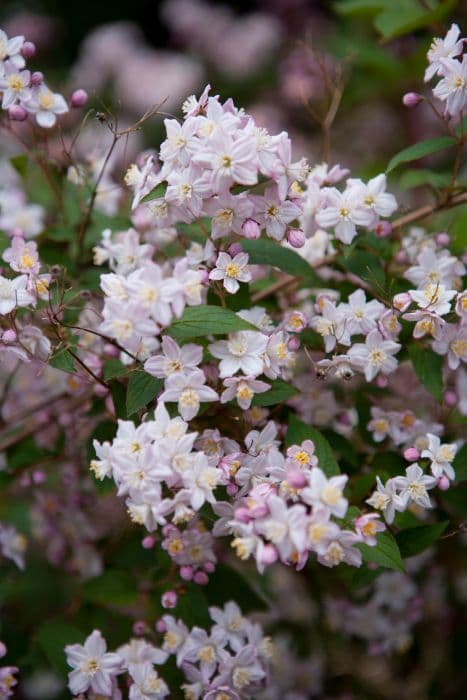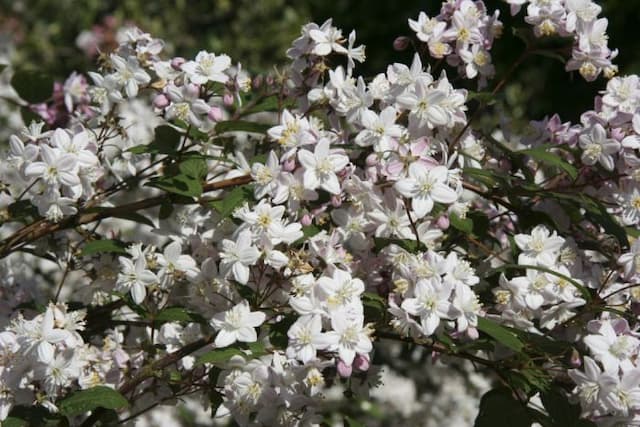Mountain Hydrangea Hydrangea serrata Tuff Stuff = 'Mak 20' (PBR) (L)
![hydrangea [Tuff Stuff]](/_next/image?url=https%3A%2F%2Fplants-admin.emdemapps.com%2Fimages%2Fplants%2F%2Fimages%2F604b5902a5d99.png&w=3840&q=75)
ABOUT
Hydrangea serrata Tuff Stuff, commonly known as mountain hydrangea, is a deciduous shrub known for its beautiful and distinctive flower display. It boasts lacecap flower heads, which are composite clusters consisting of tiny, central, fertile flowers surrounded by larger, showy, sterile flowers. The fertile flowers are typically less conspicuous, while the sterile ones are quite eye-catching, typically exhibiting shades of pink, blue, or purple, depending on the soil pH. The colors can range from soft pastel hues to bolder shades, creating a stunning visual impact. The leaves of the mountain hydrangea are toothed and oval-shaped, with a texture that can be described as slightly rough to the touch. These leaves provide a deep green, lush backdrop for the flowering spectacle, enhancing the overall appeal of the plant. The foliage may also display attractive autumn colors as the seasons transition, adding an additional layer of visual interest. This hydrangea has a rounded habit, forming a bushy appearance with numerous branches. It exudes a classic charm that's often associated with cottage gardens but can fit well into various landscape designs. Its flowers are not only beautiful to look at but also attract pollinators such as bees and butterflies, making it a valuable addition to a wildlife garden. Typically, the blooms make their appearance in early summer and can last through late summer, providing a long season of visual delight. With its captivating flowers and lush foliage, Hydrangea serrata Tuff Stuff is a versatile and appealing shrub that can be used for border displays, as a standalone specimen, or even in containers, where its ornamental qualities can be fully appreciated. Its tolerance for different soil types and adaptability to partial shade make this hydrangea a popular choice for gardeners looking to add a touch of elegance and vibrant color to their outdoor space.
About this plant
 Names
NamesFamily
Hydrangeaceae
Synonyms
Tuff Stuff Mountain Hydrangea, Sawtooth Hydrangea, Tuff Stuff Lacecap Hydrangea
Common names
Hydrangea serrata Tuff Stuff = 'Mak 20' (PBR) (L).
 Toxicity
ToxicityTo humans
Mountain hydrangea is not known to be highly toxic to humans, but it can cause gastrointestinal upset if ingested. The plant contains compounds such as hydrangin, which in significant quantities may lead to symptoms including nausea, vomiting, and diarrhea. There is also a minor risk of dermatitis from handling the plant. It is always advisable to be cautious and avoid ingesting parts of ornamental plants like the mountain hydrangea.
To pets
Mountain hydrangea is considered to be moderately toxic to pets, including cats and dogs. The toxic principle in the plant is cyanogenic glycoside, which can release cyanide when chewed or digested. Symptoms of poisoning in pets can include vomiting, diarrhea, lethargy, abdominal pain, and depression. In some cases, more severe symptoms could manifest, such as difficulty breathing and seizures. If you suspect your pet has ingested mountain hydrangea, it is advisable to contact a veterinarian immediately.
 Characteristics
CharacteristicsLife cycle
Perennials
Foliage type
Deciduous
Color of leaves
Green
Flower color
Pink
Height
2-3 feet (60-90 cm)
Spread
2-4 feet (60-120 cm)
Plant type
Shrub
Hardiness zones
5
Native area
Japan Korea
Benefits
 General Benefits
General Benefits- Ornamental Appeal: Produces beautiful lace-cap flowers that add aesthetic value to gardens and landscapes.
- Compact Size: Its relatively small size makes it suitable for urban gardens or as a potted plant in patios and decks.
- Seasonal Interest: Offers visual interest across multiple seasons with blooms in spring and summer and foliage changes in fall.
- Durability: Known as 'Tuff Stuff', it suggests the plant has a resilient nature, possibly requiring less maintenance.
- Cold Tolerance: Can withstand colder climates, making it a viable choice for gardeners in cooler zones.
- Attracts Pollinators: Flowers attract bees and butterflies, promoting biodiversity in the garden.
 Medical Properties
Medical PropertiesThis plant is not used for medical purposes.
 Air-purifying Qualities
Air-purifying QualitiesThis plant is not specifically known for air purifying qualities.
 Other Uses
Other Uses- Hydrangea tea can be created by infusing the leaves in boiling water, which is then used for flavoring beverages and for its mild sweet taste.
- The dried flowers of Hydrangea can be used to create long-lasting floral arrangements to enhance the aesthetic of indoor spaces.
- Hydrangea wood is dense and can be carved into small objects like beads or even handles for tools for those skilled in miniature woodworking.
- The large leaves of the Hydrangea can be used in crafting as a natural stencil for creating botanical prints on fabric or paper.
- Petals of the Hydrangea can be used to naturally dye fabrics, yielding a range of colors from blues to pinks depending on the pH of the soil they were grown in.
- Ink made from Hydrangea flowers can provide a unique, natural hue for artists interested in creating organic and environmentally friendly art supplies.
- The bark of Hydrangea, when processed correctly, can be made into a fibrous material that can be used to make crafts or woven into a rudimentary fabric.
- Pressed Hydrangea flowers can be used to decorate handmade paper, adding a touch of nature to personal stationery or gift cards.
- Hydrangea blooms can be used as a natural confetti for outdoor celebrations, decomposing naturally without harming the environment.
- The vibrant colors of Hydrangea flowers can be captured using photography or painting, serving as inspiration for artists and designers.
Interesting Facts
 Feng Shui
Feng ShuiThe Mountain Hydrangea is not used in Feng Shui practice.
 Zodiac Sign Compitability
Zodiac Sign CompitabilityThe Mountain Hydrangea is not used in astrology practice.
 Plant Symbolism
Plant Symbolism- Heartfelt Emotions: The hydrangea commonly symbolizes deep and heartfelt emotions, often gratitude or understanding, due to its abundant petals and full appearance.
- Apology: In some contexts, giving hydrangeas may symbolize an apology or a desire for reconciliation, possibly due to their lush and generous clusters of flowers that can be seen as overflowing with emotion.
- Vanity or Narcissism: In some traditional flower language, hydrangeas were associated with boastfulness or vanity, perhaps because of their showy and expansive blooms.
- Gratitude: The hydrangea can be a symbol of thankfulness and appreciation, making it a common gift to express gratitude.
- Perseverance: The hydrangea, particularly the Tuff Stuff variety, with its resilience and hardy nature, can represent perseverance or toughness in the face of adversity.
 Water
WaterThe mountain hydrangea should be watered deeply, ensuring that the soil is moist but not soggy, as it prefers consistent moisture. Aim to provide about 1 inch of water on a weekly basis during the growing season, increasing to 2 inches during periods of drought or extreme heat. During the winter, reduce the frequency, but do not allow the soil to completely dry out. It is best to use a soaker hose or drip irrigation to water directly at the soil level, avoiding wetting the leaves to reduce the risk of fungal diseases.
 Light
LightThe mountain hydrangea thrives in partial shade, with dappled sunlight being ideal. Avoid placing it in full sun, especially in hotter climates, as this can lead to leaf scorch. The perfect spot would be one where it can receive morning sun and afternoon shade, or filtered light beneath taller trees that provide a sun protection.
 Temperature
TemperatureMountain hydrangeas prefer a temperate climate with temperatures ranging from 60 to 75 degrees Fahrenheit during the growing season. They are hardy to about 20 degrees Fahrenheit and can survive winter temperatures down to this point. The ideal temperature range for optimal growth and flowering is between 50 and 70 degrees Fahrenheit.
 Pruning
PruningPruning mountain hydrangeas is necessary to remove dead wood and encourage new growth, thus improving blooming. Prune immediately after flowering in late summer or early fall, as the plant forms blooms on old wood. Do not prune in spring, as you may inadvertently remove flower buds. Thin out crowded stems and cut back any dead or weak branches to the base.
 Cleaning
CleaningAs needed
 Soil
SoilMountain Hydrangea prefers well-drained, moist soil rich in organic matter. A soil pH that is slightly acidic (pH 5.5 to 6.5) is ideal for this plant. Amend heavy soils with compost or peat moss to improve drainage and structure.
 Repotting
RepottingMountain Hydrangea generally does not need frequent repotting and can thrive in the same pot for several years. However, if the plant becomes root-bound or the soil is exhausted, repotting every 3 to 5 years in the spring is beneficial.
 Humidity & Misting
Humidity & MistingMountain Hydrangea prefers moderate to high humidity levels. If grown indoors, a humidity level of 50-60% is favorable for healthy growth without the need for frequent watering adjustments.
 Suitable locations
Suitable locationsIndoor
Provide bright, indirect light and keep soil moist.
Outdoor
Plant in partial shade with moist, well-draining soil.
Hardiness zone
5-9 USDA
 Life cycle
Life cycleThe Mountain hydrangea (Hydrangea serrata 'Tuff Stuff') begins its life cycle when seeds germinate in moist, well-drained soil in early spring; ideal temperatures for germination are around 70°F. After germination, seedlings establish themselves and grow into juvenile plants, developing a sturdy root system and foliage. During spring and early summer, the plant enters its vegetative stage, producing lush green leaves. By mid to late summer, it transitions to the flowering stage, showcasing dense clusters of pink, blue, or purple flowers influenced by soil acidity. Following pollination by insects, the plant produces seeds by late summer or fall, allowing for propagation. In winter, Hydrangea serrata 'Tuff Stuff' enters dormancy, with leaves often dying back in colder climates, only to resume growth from the root system or old stems as temperatures rise in the following spring.
 Propogation
PropogationPropogation time
Early spring to summer
Propogation: The most popular method of propagating Tuff Stuff Hydrangea is through softwood cuttings taken in late spring to early summer. To do this, choose a healthy, non-flowering stem and make a cutting about 4-6 inches (10-15 cm) long with several leaves. Dip the cut end in rooting hormone to encourage root development and insert the cutting into a pot filled with a moist, sterile potting mix. Cover the pot with a plastic bag to create a humid environment and place it in indirect light. Keep the soil consistently moist but not waterlogged. Roots typically develop within 4-6 weeks, after which the new plants can eventually be transplanted outdoors.








![Hydrangea [Early Sensation]](/_next/image?url=https%3A%2F%2Fplants-admin.emdemapps.com%2Fimages%2Fplants%2F%2Fimages%2F604b6150338db.png&w=640&q=75)
